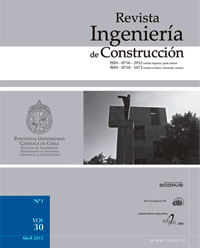Performance of cantilever reinforced concrete beams with fibers loaded with cyclic forces
DOI:
https://doi.org/10.4067/S0718-50732015000100002Keywords:
steel fiber reinforced concrete, energy dissipation, hysteresis loops, crackingAbstract
Conventional non-reinforced concrete is a brittle material with a low tensile strength and low strain capacity. To improve these mechanical properties of concrete, fibers have been used in the last decades in structural engineering applications in Colombia, South America. In this document, the authors present the mechanical behavior of cantilever beams built with three different concrete mixes: one conventional reinforced concrete mix and two steel fiber reinforced concrete mixes with two percentages of metallic fiber addition (15 kg/m3 and 30 kg/m3). The beams were tested with cyclic displacements applied with a dynamic actuator in order to evaluate the hysteresis loops and the energy dissipation capacity. Based on the results, and for the same displacement, the steel fiber reinforced concrete beams dissipates 160 % more energy than conventional reinforced concrete beams. Additionally, metallic fibers reduce the quantity and length of cracks for high displacement levels. These characteristic could be beneficial for structural applications and specifically for improving the seismic performance of concrete structures.


